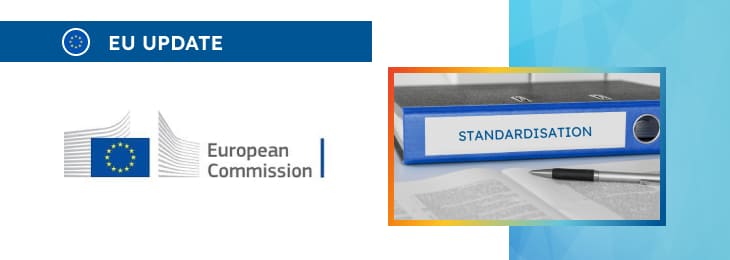The document outlines the approach to be followed in order to ensure standardisation for medical devices, facilitating further harmonisation of the relevant regulatory requirements.

Table of content
The Medical Device Coordination Group (MDCG) has published a revised guidance document dedicated to standardisation for medical devices. The document provides an overview of the applicable regulatory requirements based on the existing legal framework, as well as additional clarifications and recommendations to be taken into consideration by medical device manufacturers and other parties involved in order to ensure compliance.
At the same time, the MDCG reserves the right to make changes to the guidance and recommendations provided
, should such changes be reasonably necessary to reflect corresponding amendments to the underlying legislation.
Introduction
This document represents a comprehensive guide on various aspects of standardisation within the medical devices sector, particularly in alignment with the requirements outlined in applicable European Union (EU) legislation. It acknowledges the unique characteristics of the sector and aims to clarify the relationship between EU legislation and harmonised European standards, thus supporting stakeholders in understanding and implementing these standards effectively.
The contents of this document are structured as follows:
- Overview of EU legislation on medical devices, focusing on the “New Approach” and the “New Legislative Framework.”
- Detailed discussion on the general framework for harmonised European standards.
- Examination of the development and publication of harmonised European standards for medical devices.
- Exploration of the governance structure for standards within the medical devices sector.
The document is intended to be used in conjunction with existing legal and guidance frameworks on EU harmonisation legislation related to the health, safety, and performance of products within the internal market. For broader context and more detailed information, the document refers to additional resources available in footnotes and at the end of the text.

EU Legislation on Medical Devices within the “New Approach” and the “New Legislative Framework”
According to the guidance, the EU legislative framework for medical devices is currently governed by two key regulations:
- Regulation (EU) 2017/745 on medical devices (MDR): Effective from May 26, 2021, this regulation replaces the earlier Directives 90/385/EEC (AIMDD) and 93/42/EEC (MDD) through specific transition provisions.
- Regulation (EU) 2017/746 on in vitro diagnostic medical devices (IVDR): Applicable from May 26, 2022, this regulation supersedes Directive 98/79/EC (IVDD), also through transition provisions.
These regulations form part of the broader EU harmonisation legislation on health, safety, and product performance within the internal market, which is based on the principles of the “New Approach” and the “New Legislative Framework”. The central role of harmonised European standards (hENs) in this context cannot be overstated.
These standards are developed by designated European standardisation organisations based on specific requests (formerly known as “mandates”) issued by the European Commission. In terms of legal definitions, Articles 2(70) MDR and 2(73) IVDR describe a harmonised standard as “a European standard adopted on the basis of a request made by the Commission for the application of Union harmonisation legislation”.
However, Articles 8 MDR and IVDR clarify that references to harmonised standards pertain specifically to those whose references have been published in the Official Journal of the European Union (OJEU). Products that are designed and manufactured according to these harmonised European standards, as published in the OJEU, are presumed to conform to the relevant legal requirements.
This presumption of conformity simplifies various processes, including conformity assessment, CE marking, and market surveillance. However, the use of these standards remains voluntary.
The General Framework for Harmonised European Standards
The principles of the “New Approach” and the “New Legislative Framework” are implemented through a specific legal and guidance framework that supports European standardisation and harmonised European standards.
The key references include:
- Regulation (EU) No 1025/2012 on European standardisation: This regulation, effective across all Member States since January 1, 2013, sets out the legally binding provisions on European standardisation, covering definitions, standardisation organisations, requests, formal objections, and the Committee on Standards.
- Court of Justice of the European Union Rulings: Relevant rulings provide critical interpretations that impact the entire EU standardisation system.
- Vademecum on European Standardisation: This document compiles essential guidance on European standardisation policy, including the role and use of harmonised standards.
- Communications from the European Commission: Various communications outline the EU’s strategic vision for standardisation, aiming to set global standards and enhance the functioning of the Single Market.
In practice, the implementation of these references is supported by specific procedural documents, which are available through cooperation between the European Commission and European standardisation organisations. These documents include procedures and guidance for the CEN-CENELEC Management Centre, HAS consultants, and technical committees, among others.
Voluntary Use of Standards
In line with the general principles of EU harmonisation legislation, the use of standards within the medical devices sector is voluntary. Regulation (EU) 1025/2012 clearly states that standardisation is based on voluntary technical or quality specifications.
This voluntary nature is also reflected in the definitions provided by the regulation, which distinguish between different types of standards, such as international, European, and national standards. Even within the medical devices sector, the voluntary use of standards allows manufacturers to choose between applying the technical solutions provided by harmonised European standards, non-harmonised standards, or even developing their own solutions.
The key requirement is that these solutions must adequately demonstrate compliance with the applicable legal requirements. For harmonised standards cited in the OJEU, presumption of conformity can be claimed for the relevant requirements. However, this does not impose an obligation on manufacturers to use any specific standard.
The voluntary use of standards ensures flexibility for manufacturers, who retain ultimate responsibility for ensuring compliance with the legal requirements. While national authorities and notified bodies may consider harmonised standards in their assessments, they cannot mandate their use.
This approach aligns with the broader principles of the “New Approach” and the “New Legislative Framework,” which emphasize the voluntary nature of standardisation.
Harmonised European Standards in Support of EU Legislation on Medical Devices
As further explained in the guidance, harmonised European standards are developed by designated European standardisation organisations, such as CEN, CENELEC, and ETSI, based on standardisation requests issued by the European Commission. These requests align with specific EU legislation and aim to cover the essential requirements outlined in that legislation.
The relationship between the standards and legal requirements is detailed in the standards’ forewords and especially in the informative annexes known as “Annex Z”.
Development and Assessment by HAS Consultants
The development of harmonised standards is closely monitored by HAS consultants, who ensure that the standards adequately cover the legal requirements they aim to address. Their assessments are crucial for determining whether the standards can be referenced in the OJEU.
Publication in the OJEU and Presumption of Conformity
Once a harmonised standard has been developed and assessed, its reference can be published in the OJEU, conferring a presumption of conformity with the relevant legal requirements. This publication is a key milestone in the standardisation process, as it provides legal clarity and certainty to manufacturers and other stakeholders.
International Aspects of Standardisation
Standardisation within the EU does not occur in isolation; international standards also play a significant role. The EU approach to standardisation is influenced by global standards and practices, ensuring that its standards are compatible with those used in other major markets.
The “state of the art” is a key concept in the standardisation process, referring to the most current and advanced stage of technical development. Standards that reflect the state of the art are crucial for ensuring that products meet the latest safety and performance requirements.
The Court of Justice of the European Union has issued several rulings that impact the standardisation process, providing legal interpretations that influence how standards are developed and applied within the EU. In addition to harmonised standards, the European Pharmacopoeia and other common specifications also play a role in the standardisation process, particularly for specific types of medical devices.
Governance Structure for Standards in the Medical Devices Sector
Under the general rule, the Medical Device Coordination Group oversees the development and implementation of standards within the medical devices sector. Working Group 2, specifically focused on standards, plays a key role in this governance structure.
The CEN-CENELEC Sector Forum on Healthcare Standards (SFHS) is another important body within the governance structure, facilitating cooperation and coordination among stakeholders involved in healthcare standardisation.
Conclusion
In summary, the present guidance document provides an overview of the role and use of harmonized European standards within the medical devices sector, emphasizing their importance in supporting compliance with EU legislation. While the use of these standards remains voluntary, their application can significantly simplify the processes related to conformity assessment, CE marking, and market surveillance.
How Can RegDesk Help?
RegDesk is an AI-powered Regulatory Information Management System that provides medical device companies with regulatory intelligence for over 120 markets worldwide. It can help you prepare and publish global applications, manage standards, run change assessments, and obtain real-time alerts on regulatory changes through a centralized platform. Global expansion has never been this simple.

